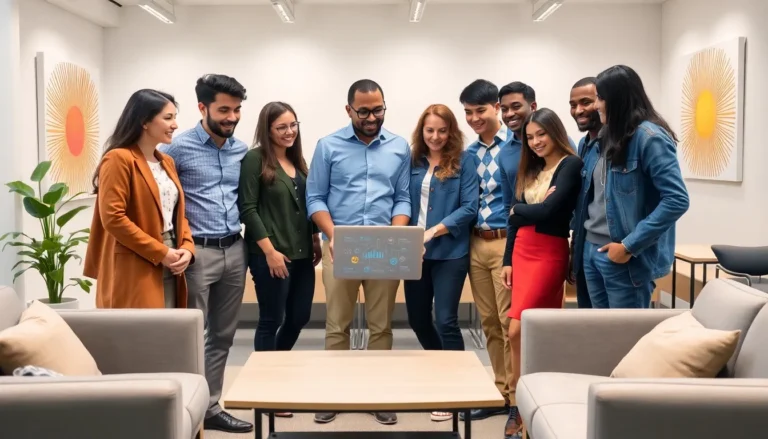In a world buzzing with the same old routines, transformational ideas are the secret sauce that can spice things up. They’re not just for the dreamers and innovators; these ideas can revolutionize everyday life. Imagine turning mundane tasks into exciting adventures or transforming a dull workspace into a creativity hotspot. Sounds appealing, right?
Table of Contents
ToggleOverview of Transformational Ideas
Transformational ideas hold the key to revitalizing daily life. These concepts elevate routine tasks, making them engaging and dynamic. Individuals often discover that integrating such ideas into their environments fosters creativity. Workspaces can transition from uninspiring to vibrant, sparking motivation among team members.
Incorporating innovative approaches leads to enhanced productivity. For instance, introducing flexible work arrangements can reshape employee attitudes. Additionally, community-based projects encourage collaboration and boost morale. These initiatives empower people, cultivating a sense of purpose and belonging.
Transformational ideas also extend to personal life. Adopting new habits, like mindfulness practices, can significantly impact well-being. Simple changes, such as rearranging furniture or introducing plants, breathe new life into spaces. Embracing these shifts promotes a refreshed perspective and a heightened sense of awareness.
Organizations often benefit from implementing transformational strategies. By prioritizing employee feedback, leadership teams can refine processes and enhance workplace culture. Furthermore, exploring diverse perspectives fosters innovation, keeping teams engaged and aligned with goals.
Through active exploration, individuals shape their realities. Each small shift builds towards significant change, creating pathways to success. Success hinges on openness to new possibilities and a willingness to embrace transformation. Integrating these ideas ensures that daily routines are not just tasks but experiences that inspire growth and creativity.
Key Elements of Transformational Ideas

Transformational ideas stem from distinct elements that drive change and positivity in everyday life. Vision and purpose guide these concepts, while innovation and creativity fuel their execution.
Vision and Purpose
Vision and purpose form the backbone of transformational ideas. A clear vision articulates the desired outcome, making it easy for individuals and organizations to align their efforts. Purpose, on the other hand, inspires action and motivates individuals. When the vision reflects genuine intentions, it resonates deeply with others, encouraging collaboration. Effective implementation requires constant re-evaluation of these elements to stay relevant and impactful. Lastly, leaders can amplify the vision’s significance by communicating its value, ensuring everyone feels invested in the collective goal.
Innovation and Creativity
Innovation and creativity serve as catalysts for transforming ideas into reality. Organizations benefit when they cultivate an environment that promotes original thinking. Encouraging diverse perspectives enhances problem-solving capabilities. Allowing employees to experiment leads to unexpected breakthroughs and innovative solutions. Exploration of new methods shifts conventional paradigms and challenges norms. Creativity emerges more readily when teams have the freedom to brainstorm and share ideas openly. Emphasizing a culture of creativity significantly expands opportunities for growth and development both personally and professionally.
Real-World Applications
Transformational ideas manifest in various sectors, demonstrating their adaptability and effectiveness.
Case Studies in Business
Company A successfully implemented flexible work arrangements and observed a 20% increase in productivity. Engaged employees reported higher morale, illustrating the positive effects of a supportive work environment. Furthermore, Company B launched an innovative project aimed at community outreach, resulting in enhanced brand loyalty. Diverse perspectives in decision-making processes led to groundbreaking solutions. Research indicates that businesses embracing feedback mechanisms significantly outperform those that do not.
Transformational Ideas in Education
Schools incorporating project-based learning witnessed improved student engagement and retention rates. A middle school introduced mentoring programs that connected students with industry professionals, sparking interest in various career paths. Collaborative environments fostered creativity and teamwork among students. Data from educational institutions reveals that integrated technology enhances learning experiences. Innovative curricula emphasizing critical thinking equip students with essential skills, preparing them for future challenges.
Challenges and Considerations
Implementing transformational ideas presents various challenges and considerations. These factors significantly influence their effectiveness in creating lasting change.
Resistance to Change
Resistance to change often emerges when individuals feel threatened by new concepts. Employees may fear job insecurity or worry that adjustments disrupt established routines. Engaging team members early in the process encourages buy-in and collaboration. Open communication fosters understanding and minimizes anxiety surrounding transformation. Providing training or resources eases the transition and builds confidence in adapting to new practices. When organizations demonstrate the benefits of change, such as Company A’s 20% productivity increase, team members become more receptive to innovative ideas.
Sustainability of Ideas
Sustaining transformational ideas requires ongoing commitment and evaluation. Regular reassessment of their impact maintains relevance and ensures alignment with changing needs. Developing a supportive culture promotes continuous improvement and innovation. Employee feedback plays a vital role in this process, allowing organizations to refine approaches and strategies. Implementing small adjustments contributes to long-term success and overall satisfaction. In education, schools that adapted project-based learning engaged students, reflecting the importance of sustainable practices for lasting outcomes.
Future Trends in Transformational Ideas
Emerging trends emphasize the need for adaptive strategies in various fields. Artificial intelligence is driving personalized experiences in customer service and education. Companies integrating AI tools are enhancing efficiency, as seen with Company A’s advanced analytics leading to a 25% increase in response times.
Sustainability remains a priority for organizations. Implementing eco-friendly practices attracts both customers and employees. Businesses pursuing greener operations report an uptick in brand loyalty, underscoring the importance of corporate social responsibility.
Remote collaboration tools continue to evolve, shaping team dynamics. Platforms offering seamless integration foster a sense of connection among remote workers. Studies indicate that companies utilizing these tools observe a 30% improvement in team communication.
Diversity and inclusivity in decision-making are gaining traction. Organizations embracing varied perspectives often experience increased innovation. Data suggests that diverse teams produce 19% more revenue than their less diverse counterparts.
Health and wellness initiatives are increasingly prominent. Programs focusing on mental health and work-life balance contribute to employee satisfaction. For instance, firms with comprehensive wellness plans see a 40% decrease in turnover rates.
Lastly, continuous learning and skill development are vital. Employees who engage in ongoing training demonstrate higher engagement levels and job satisfaction. Leaders prioritizing education are better positioned to adapt to changing market demands.
These future trends highlight the dynamic landscape of transformational ideas, revealing the interconnectedness of innovation, sustainability, and team well-being.
Transformational ideas hold the potential to reshape not just individual experiences but entire organizations. By embracing innovation and fostering a culture of creativity, businesses and communities can thrive in an ever-evolving landscape. The integration of diverse perspectives and adaptive strategies ensures that these ideas remain relevant and impactful.
As they navigate the challenges of change, organizations must prioritize open communication and employee engagement to cultivate a supportive environment. The future will demand a commitment to sustainability and continuous learning, reinforcing the importance of these transformative concepts. Ultimately, it’s the small shifts that pave the way for significant progress, inspiring growth and creativity in everyday life.









